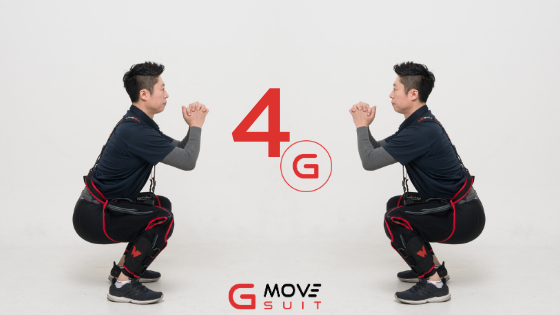CHOOSING THE PRESSURE OF THE GMOVE-SUIT
GMOVE-SUIT is perfectly suited for blood flow controlling, depending on the patient’s condition and the morphology of his legs. In rehabilitation, it is strongly recommended to check if the patient has no history, such as hospitalization or complications in the blood circulation (see contraindications). The difference in morphology and size of the muscles requires that the straps have to be be very tight, so the suit is well fixed on the patient. As a tool, a finger should not be able to pass between the suit and the patient’s body.
The power of the pressure has to be defined according to the muscle mass of the legs that are going to be compressed. The larger the muscles are, the higher the pressure has to be. For a 4G training, the pressure will oscillate between 80 and 120 mmHg.
Although many studies have produced beneficial muscle adaptations with the same absolute pressures applied to everyone, it is recommended that the pressure as to be as high as possible. It is therefore recommended to adjust the pressure at the start-up and increase it again during exercise, because higher pressure is providing better muscle performance.
TRAININGS
ACTIVE FORCE: The pressure applied during the exercise can also be dictated to some extent related to the load at maximum effort and reaching failure. In 4G mode, the training threshold is between 40 and 80% of the maximum load.
ACTIVE CARDIO: Intensities used during BFR are generally low (45% of heart rate reserve or 40% of VO2 max. It is however important to check and increase the pressure during cardio exercise.
PASSIVE: This step is highly recommended for increased recovery after intensive exertion by reducing the pressure by 20% compared to the active mode. These stretching exercises should be done for 5 minutes.
VOLUME
The advantage of the GMOVE-SUIT is to offer a wider range of use, compared to conventional BFR treatment. Muscular hypertrophy requires to not exceed too long rest times, in order to maintain the training benefits, while avoiding muscular stress (prone to injury in the medium term). This explains a predefined cycle choice of 60 seconds of work, 20 seconds of rest (with deflation of the compression), then 20 seconds of very intense training and finally 20 seconds of rest. This two minutes cycle repeats between 5 and 15 times, but can reach 30 repetitions for an ACTIVE CARDIO workout.

